This information has been commissioned by the Goulburn Murray Valley (GMV) Fruit Fly Project and is funded by the Victorian Government’s Managing Fruit Fly Regional Grants Program. Use of this material in its complete and original format, acknowledging its source, is permitted, however unauthorised alterations to the text or content is not permitted.
Goulburn Murray Valley Trapping Grip – December 2021 review and January 2022 outlook
- Cobram data for 2020 and 2021 has been excluded from this report as the separation of numbers of wild flies from sterile flies (part of the SITplus sterile pilot insect technique project (SIT) in Cobram, 2019 – 2021) has not been completed.
- Populations, as measured by the Goulburn Murray Valley (GMV) trapping grid, are showing the usual pattern for this time of year (Fig. 1) with an increase in trapped Queensland fruit fly (Qfly) occurring from mid-September. However, it’s been a little different in the spring of 2021 in that the usual drop-off in numbers in November has not occurred. These flies, considered to be overwintering adults, should have died out but weather conditions extended good conditions for the survival of fruit flies and fruit for them to infest. The result is potentially high numbers of eggs and larvae in fruit and pupae in the ground.
- Trapped fruit fly numbers from mid-October 2021 to mid-December 2021, with Cobram data excluded, were lower than those in the same period of the last two years (Fig.2). So, despite the extended length of suitable fruit fly conditions the numbers are lower than the last couple of years. Again, though, that doesn’t mean that these adult flies haven’t been able to lay their eggs onto many more fruit than usual. If people have been able to remove unwanted fruit and fruit trees, this perceived problem will not eventuate.
- Normally, fruit fly populations start their summer surge during the second fortnight (i.e. weeks 3 and 4) of December (Fig. 3). This year, numbers were lower, during the first half of December compared with all previous years (Fig. 3). Weather conditions during the second half of December are likely to be favourable for the survival of immature fruit fly (eggs, larvae and pupae) meaning that adult fruit fly could emerge in large numbers in early January.
- Also, as usual for this time of year the greatest numbers of trapped fruit fly occur in urban areas (Fig. 4) rather than rural areas – with peri-urban spots in between. Urban locations experience higher winter temperatures than rural locations (heat sink effect) and the diversity of fruiting plants available of infesting is also higher in urban areas. These flies peak in December/ January and trapping populations decline over the late summer in urban areas. However, it is very likely that these flies don’t actually die out – they just move through peri-urban locations and into commercial orchards in early autumn – when their crops are ripening.
Hot spots
- Most of the 33 sites in Cobram urban and some of the 61 sites in the Cobram rural area trapped large numbers of fruit fly in the period from 1 September 2021. However, most of these flies will soon be identified as sterile and not wild.
- Other locations with 8 or more wild flies per trapping site in the first fortnight of December 2021 were:
- Echuca – 1 site
- Kyabram – 1 site
- Mooroopna – 1 site
January outlook
- Numbers of trapped fruit fly generally decline either in late October or through November after a small September peak (Fig. 1). This did not happened during the latter part of 2021 although overall numbers have still been lower than in corresponding times of previous years.
- There is a risk that adult flies that survived the winter have survived longer into late spring in 2021 than in previous years meaning they had time to infest more fruit than usual.
- Depending on how well people have kept their gardens and orchards clear of unwanted fruit or protected from fruit fly, adult fruit fly numbers will recommence increasing in late December and will continue this increase throughout January to April with a small decline during January when very hot, dry weather occurs.
Advice for home gardeners
Fruit fly are present in increasing numbers in urban locations, right now. They are very likely to increase over the summer and cause severe damage to garden crops – unless area-wide management strategies are in place. Essential control measures include:
- Remove unwanted fruiting plants
- Harvest fruit and use or destroy fruit
- Place traps out and check regularly for sign of fruit fly population build-up
- Check ripening fruit for sting marks or maggots
- Netting whole plants, fruiting branches, fruit trusses or individual fruit is a sure-fire way of protecting your crops from fruit fly
- Baiting is not recommended for backyard growers unless everyone in the area starts baiting, and continues together
- Don’t restrict your vigilance to your backyard – fruit fly can be in fruit in your front yard, nearby vacant land, untended crops, roadsides and creek banks
- Fruit fly will build up over November onwards in urban areas
- Fruit fly will spread from urban areas to rural areas as commercial orchards start to ripen – generally from March onwards
- Fruit fly management in urban areas early in the season will assist in reducing fruit fly’s impact on commercial growers later in the season
Advice for peri-urban landowners
- Fruit fly are in low, but increasing, numbers in peri-urban areas right now
- Use traps and check fruit for stings and larvae now so that you know when fruit fly is starting to build up
- Fruit fly move from urban sites through peri-urban areas and into commercial orchards during the late summer and autumn. Control of fruit fly in your locations will assist commercial growers in controlling fruit fly in their crops.
- Removal of fruiting plants or their fruit will help in reducing the numbers of fruit fly breeding in your area
- Baiting can be very effective in peri-urban locations if fruit fly numbers build up to damaging levels
- Consider using netting for special crops
Advice for commercial growers
- Fruit fly is not a problem in rural locations as yet but –
- Make sure you have traps out in the orchard and surrounding the house and sheds
- Ensure traps, lures and toxicants are within their use-by date and replace or re-charge as per label instructions
- If your orchard is close to towns mentioned above as hot spots make sure you check your traps regularly as well as checking your crops and other fruiting plants in and around your orchard – house paddocks, front yard, roadsides, creek banks, etc.
- In more remote areas fruit fly numbers will commence building up in late summer and early autumn
- Baiting is very efficient at controlling fruit fly so ensure you have stocks in storage inside their use-by date, especially if fruit fly was present in your area last year.
Weather forecast
- Bureau of Meteorology (BOM) data predicts there is a 50:50 chance that more rain will fall during January 2022 than average (which is 25mm to 50mm) (FIG. 5).
- Maximum temperatures will remain similar (50% to 60% chance of being higher than average) to the average of 30˚C to 33˚C (FIG. 6).
- The chances that minimum temperatures will be higher than average (15˚C to 18˚C) are high (60% to 65% chance) (FIG. 7).
- These conditions are favourable for fruit fly survival and population build-up, however normal high temperatures and low rainfall during January 2022 will cut the growing fruit fly population significantly. This is due to lower availability of atmospheric moisture to adults (although home and orchard-irrigation will negate this), low moisture causing fruit drop and smaller fruit and therefore
fewer fruit for fruit fly to infest and high heat killing adults as well as eggs and larvae in exposed fruit (on ground and on-tree) and pupae in exposed ground. This scenario generally occurs in the Goulburn Murray Valley but it has not been the case, for a number of years recently. This was due to an extended La Niña weather pattern existing in South Eastern Australia from March 2020 to early 2021. Currently another La Niña weather pattern is in place but, despite this, BOM data suggest that La Niña will not lead to increased rainfall, at least during January 2022.
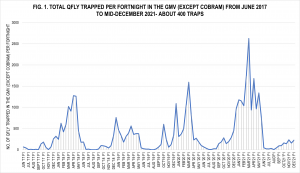
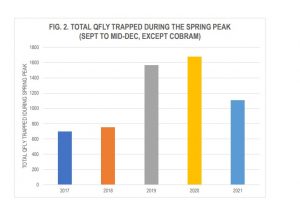
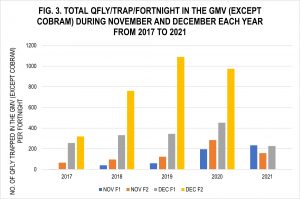
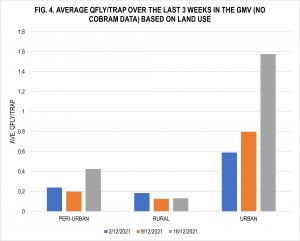
*Cobram data removed due to delayed separation of wild fruit fly from sterile fruit fly as a result of the SITplus sterile insect technique pilot trial over Cobram.
FIG. 5. Chance of total rainfall forecast for November 2021 being higher than the 10-year average
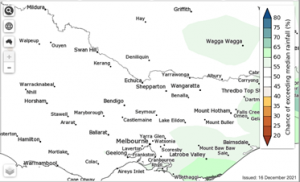
FIG. 6. Chance of maximum temperatures forecast for November 2021 being higher than the 10-year average
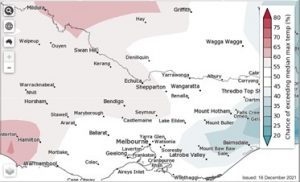
FIG. 7. Chance of minimum temperatures forecast for November 2021 being higher than the 10-year average
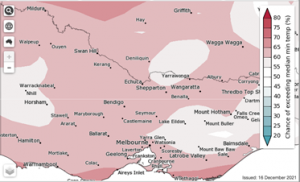
Goulburn Murray Valley Fruit Fly Project
For assistance in managing fruit fly, contact the Project Coordinator at the GMV Fruit Fly Office by phoning (03) 5871 9222 or emailing gmvfruitfly@moira.vic.gov.au. For more information on fruit fly control and area wide management strategies visit www.fruitflycontrol.com.au
This report was produced and supplied by Janren Consulting Pty Ltd for the purpose of the GMV Fruit Fly Project.
